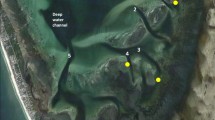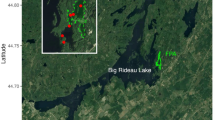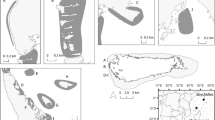Abstract
To understand habitat requirements of green turtles in an important foraging area subject to both anthropogenic and natural perturbations, we examined residency, home range and habitat use of juvenile, sub-adult and adult green turtles (Chelonia mydas) in Port Curtis, Australia, using passive acoustic telemetry. Acoustic tags were attached to turtles at Pelican Banks (n = 33) and Wiggins Island (n = 16). Between May 2013 and September 2014, tagged turtles were detected > 1.3 million times by 46 acoustic receivers. Data demonstrated variability in residence index and home range size between Pelican Banks and Wiggins Island that was largely attributed to larger body size at Pelican Banks and habitat differences. Tide had a significant influence of movement and habitat use. At Pelican Banks turtles moved into intertidal seagrass beds at high tide and retreated to the channel at low tide. At Wiggins Island, high tide 50% KUD area was more than double low tide area and turtles moved into the mangroves at high tide and retreated to channels at low tide. Diet reflected availability of food resources; seagrass dominated diet at Pelican Banks whereas epiphytic red algae dominated diet at Wiggins Island. There was no evidence of a diurnal shift in home range or habitat use. The use of intertidal areas by both turtles and small recreational craft during high tide at Pelican Banks resulted in increased risk of vessel strike. Unusually short residency at Pelican Banks suggested that animals had either relocated to another foraging area or a combination of recent flooding, port development and reduced seagrass coverage during the period of monitoring resulted in higher emigration rates than previously demonstrated for this species. Acoustic telemetry is a valuable tool for obtaining fine-scale, long- term data on movement and residency of green turtles.







Similar content being viewed by others
Data availability
The datasets generated during and/or analysed during the current study are available from the corresponding author on reasonable request.
References
Aitchison J (1986) The statistical analysis of compositional data. Monographs on statistics and applied probability. Chapman and Hall, London, p 416
Babcock RC, Baird ME, Pillans R, Patterson T, Clementson LA, Haywood ME, Rochester W, Morello E, Keely N, Oubelkheir K, Fry G, Dunbadin M, Perkins S, Forcey K, Cooper S, Donovan A, Kenyon R, Carlin G, Limpus C (2015) Towards an integrated study of the Gladstone marine system. CSIRO Oceans and Atmosphere Flagship, Brisbane
Babcock RC, Bustamante RH, Fulton EA, Fulton DJ, Haywood MDE, Hobday AJ, Kenyon R, Matear RJ, Plagányi EE, Richardson AJ, Vanderklift MA (2019) Severe continental-scale impacts of climate change are happening now: extreme climate events impact marine habitat forming communities along 45% of Australia’s coast. Front Mar Sci 6:411. https://doi.org/10.3389/fmars.2019.00411
Balazs GH (1994) Homeward bound: satellite tracking of Hawaiian green turtles from nesting beaches to foraging pastures. In: Proceedings of the 13th annual symposium on sea turtle biology and conservation. US Dep Commer, NOAA Tech Memo NMFS. pp 135–138
Bino G, Kingsford RT, Grant T, Taylor MD, Vogelnest L (2018) Use of implanted acoustic tags to assess platypus movement behaviour across spatial and temporal scales. Sci Rep 8:5117. https://doi.org/10.1038/s41598-018-23461-9
Brill RW, Balazs GH, Holland KN, Chang RKC, Sullivan S, George JC (1995) Daily movements, habitat use and submergence intervals of normal and tumor-bearing juvenile green turtles (Chelonia mydas L.) within a foraging area in the Hawaiian islands. J Exp Mar Biol Ecol 185:203–218
Calenge C (2006) The package “adehabitat” for the R software: a tool for the analysis of space and habitat use by animals. Ecol Modell 197:516–519
Chaloupka M, Limpus CJL (2001) Trends in the abundance of sea turtles resident in southern Great Barrier Reef waters. Biol Conserv 102:235–249
Chaloupka M, Limpus CJL, Miller J (2004) Green turtle somatic growth dynamics in a spatially disjunct Great Barrier Reef metapopulation. Coral Reefs 23(3):325–335. https://doi.org/10.1007/s00338-004-0387-9
Chambault P, de Thoisy B, Huguin M et al (2018) Connecting paths between juvenile and adult habitats in the Atlantic green turtle using genetics and satellite tracking. Ecol Evol 8:12790–12802. https://doi.org/10.1002/ece3.4708
Chambault P, Dalleau M, Nicet J, Mouquet P, Ballorain K, Jean C, Ciccione S, Bourjea J (2020) Contrasted habitats and individual plasticity drive the fine scale movements of juvenile green turtles in coastal ecosystems. Mov Ecol 8:1. https://doi.org/10.1186/s40462-019-0184-2
Christiansen F, Esteban N, Mortimer JA, Dujon AM, Hays GC (2017) Diel and seasonal patterns in activity and home range size of green turtles on their foraging grounds revealed by extended Fastloc-GPS tracking. Mar Biol 164:10. https://doi.org/10.1007/s00227-016-3048-y
Crear DP, Lawson DD, Seminoff JA, Eguchi T, LeRoux RA, Lowe CG (2017) Habitat use and behavior of the East Pacific Green Turtle, Chelonia mydas, in an urbanized system. Bull South Calif Acad Sci 116(1):17–32
Cribb AB (1996) Seaweeds of Queensland: a naturalist’s guide. The Queensland Naturalists’ Club Inc., Brisbane
Davies J, Sankey T, Bryant C, Rasheed M (2015) Long term seagrass monitoring in Port Curtis: quarterly permanent transect monitoring progress. https://doi.org/10.13140/RG.2.1.2116.6560
Dennis MM, Diggles BK, Faulder R, Olyott L, Pyecroft SB, Gilbert GE, Landos M (2016) Pathology of finfish and mud crabs Scylla serrata during a mortality event associated with a harbour development project in Port Curtis, Australia. Dis Aquat Org 121:173–188. https://doi.org/10.3354/dao03011
Dethmers KEM, Broderick D, Moritz C, Fitzsimmons NN, Limpus CJ, Lavery S, Whiting S, Guinea M, Prince RIT, Kennett R (2006) The genetic structure of Australasian green turtles (Chelonia mydas): exploring the geographical scale of genetic exchange. Mol Ecol 15:3931–3946
Dethmers KEM, Jensen MP, FitzSimmons NN, Broderick D, Limpus CJ, Moritz C (2010) Migration of green turtles (Chelonia mydas) from Australasian feeding grounds inferred from genetic analyses. Mar Freshw Res 61:1376–1387
Doody SJ, Roe J, Mayes P, Ishiyama L (2009) Telemetry tagging methods for some freshwater reptiles. Mar Freshw Res 60:293–298
Duarte CM (2002) The future of seagrass meadows. Environ Conserv 29:192–206
Erftemeijer PLA, Lewis RR (2006) Environmental impacts of dredging on seagrasses: a review. Mar Pollut Bull 52:1553–1572
Fieberg J, Kochanny CO (2005) Quantifying home-range overlap: the importance of the utilization distribution. J Wildl Manag 69(4):1346–1359
FitzSimmons NN, Limpus CJ (2014) Marine turtle genetic stocks of the Indo-Pacific: identifying boundaries and knowledge gaps. Indian Ocean Turtle Newsl 20:2–18
Flint M, Eden PA, Limpus CJ, Owen H, Gaus C, Mills PC (2014) Clinical and pathological findings in green turtles (Chelonia mydas) from Gladstone, Queensland: investigations of a stranding epidemic. EcoHealth 12(2):298–309. https://doi.org/10.1007/s10393-014-0972-5
Fujisaki I, Hart KM, Sartain-Iverson AR (2016) Habitat selection by green turtles in a spatially heterogeneous benthic landscape in Dry Tortugas National Park, Florida. Aquat Biol 24:185–199. https://doi.org/10.3354/ab00647
Gaus C, Grant S, Jin NL, Goot K, Chen L, Villa AC, Neugebauer F, Qi L, Limpus C (2012) Investigation of contaminant levels in green turtles from Gladstone. National Research Centre for Environmental Toxicology (Entox), p 160
Gredzens C, Marsh H, Fuentes MMPB, Limpus CJ, Shimada T, Hamman M (2014) Satellite tracking of sympatric marine megafauna can inform the biological basis for species co-management. PLoS ONE 9(6):e98944. https://doi.org/10.1371/journal.pone.0098944
Griffin LP, Smith BJ, Cherkiss MS, Crowder AG, Pollock CG, Hillis-Starr Z, Danylchuk AJ, Hart KM (2020) Space use and relative habitat selection for immature green turtles within a Caribbean marine protected area. Anim Biotelem 8:22. https://doi.org/10.1186/s40317-020-00209-9
Hamann M, Godfrey MH, Seminoff JA, Arthur K, Barata PCR, Bjorndal KA, Bolten AB, Broderick AC, Campbell LM, Carreras C, Casale P, Chaloupka M, Chan SKF, Coyne MS, Crowder LB, Diez CE, Dutton PH, Epperly SP, FitzSimmons NN, Formia A, Girondot M, Hays GC, Cheng IJ, Kaska Y, Lewison R, Mortimer JA, Nichols WJ, Reina RD, Shanker K, Spotila JR, Tomas J, Wallace BP, Work TM, Zbinden J, Godley BJ (2010) Global research priorities for sea turtles: informing management and conservation in the 21st century. Endanger Species Res 11(3):245–269. https://doi.org/10.3354/esr00279
Hays GC, Scott R (2013) Global patterns for upper ceilings on migration distance in sea turtles and comparisons with fish, birds and mammals. Funct Ecol 27(3):748–756. https://doi.org/10.1111/1365-2435.12073
Hays GC, Adams CR, Broderick AC, Godley BJ, Lucas DJ, Metcalfe JD, Prior AA (2000) The diving behaviour of green turtles at Ascension Island. Anim Behav 59:577–586
Hays GC, Broderick AC, Glen F, Godley BJ (2002) Change in body mass associated with long-term fasting in a marine reptile: the case of green turtles (Chelonia mydas) at Ascension Island. Can J Zool 80(7):1299–1302. https://doi.org/10.1139/z02-110
Hazel J, Gyuris E (2006) Vessel-related mortality of sea turtles in Queensland, Australia. Wildl Res 33:149–154
Hazel J, Lawler IR, Marsh H, Robson S (2007) Vessel speed increases collision risk for the green turtle Chelonia mydas. Endanger Species Res 3:105–113
Hazel J, Lawler IR, Hamann M (2009) Diving at the shallow end: green turtle behaviour in near-shore foraging habitat. J Exp Mar Biol Ecol 371(1):84–92
Hazel J, Hamman M, Lawler IR (2013) Home range of immature green turtles tracked at an offshore tropical reef using automated passive acoustic technology. Mar Biol 160:617–627. https://doi.org/10.1007/s00227-012-2117-0
Hazen EL, Maxwell SM, Bailey H, Bograd SJ, Hamann M, Gaspar P, Godley BJ, Shillinger GL (2012) Ontogeny in marine tagging and tracking science: technologies and data gaps. Mar Ecol Prog Ser 457:221–240
Heithaus MR, Frid A, Wirsing AJ, Dill LM, Fourqurean JW, Burkholder D, Thomson J, Bejder L (2007) State-dependent risk-taking by green sea turtles mediates top-down effects of tiger shark intimidation in a marine ecosystem. J Anim Ecol 76:837–844
Hirth HF, Huber M, Frohm T, Mala T (1992) A natural assemblage of immature green (Chelonia mydas) and hawksbill (Eretmochelys imbricata) turtles on the fringing reef of Wuvulu Island, Papua New Guinea. Micronesica 25:145–153
Hodgson AJ, Marsh H (2007) Response of dugongs to boat traffic: the risk of disturbance and displacement. J Exp Mar Biol Ecol 340(1):50–61. https://doi.org/10.1016/j.jembe.2006.08.006
Ivlev VS (1961) Experimental ecology of the feeding of fishes. Yale University Press, New Haven
Kernohan BJ, Gitzen RA, Millspaugh JJ (2001) Analysis of animal space use and movements. In: Millspaugh JJ, Marzluff JM (eds) Radio tracking and animal populations. Academic Press, San Diego
Limpus CJ (2008) A biological review of Australian Marine Turtles. 2. Green Turtle, Chelonia mydas (Linnaeus). Queensland Environmental Protection Agency, Brisbane
Limpus CJ, Limpus DJ (2000) Mangroves in the diet of Chelonia mydas in Queensland, Australia. Mar Turtle Newsl 13:15
Limpus CJ, Read PC (1985) The green turtle, Chelonia mydas, in Queensland: population structure in a coral reef feeding ground. In: Grigg G, Shine R, Ehmann H (eds) Biology of Australian frogs and reptiles. Surrey Beatty and Sons, Sydney
Limpus C, Walter D (1980) The growth of immature green turtles (Chelonia mydas) under natural conditions. Herpetologica 36:162–165
Limpus CJ, Miller JD, Paramenter CJ, Reimer D, McLachlan N, Webb R (1992) Migration of green (Chelonia mydas) and loggerhead (Caretta caretta) turtles to and from eastern Australian rookeries. Wildl Res 19:347–357
Limpus CJ, Couper PJ, Read MA (1994) The green turtle, Chelonia mydas, in Queensland: population structure in a warm temperate feeding area. Mem Queensl Mus 35:139–154
Limpus CJ, Limpus DJ, Arthur KE, Parmenter CJ (2005) Monitoring green turtle population dynamics in Shoalwater Bay 2000–2004. Queensland Environmental Protection Agency and the Great Barrier Reef Marine Park Authority. Research Publication No. 83
Limpus CJ, Limpus DJ, Savige M, Shearer D (2012) Health assessment of green turtles in south and central Queensland following extreme weather impacts on coastal habitat during 2011. Department of Environment and Resource Management, Brisbane
Limpus CJ, Parmenter CJ, Chaloupka M (2013) Monitoring of Coastal Sea Turtles: gap analysis 2. Green turtles, Chelonia mydas, in the Port Curtis and Port Alma Region. Report produced for the ecosystem research and monitoring program advisory panel as part of Gladstone Ports Corporation’s Ecosystem Research and Monitoring Program
Lutcavage ME, Lutz PL (1997) Diving physiology. In: Lutz PL, Musick JA (eds) The biology of sea turtles, vol 1. CRC Press, Boca Raton
Lutcavage ME, Plotkin PT, Witherington B, Lutz PL (1997) Human impacts on sea turtle survival. In: Lutz P, Musick J (eds) The biology of sea turtles. CRC Press, Boca Raton
MacDonald BD, Lewison RL, Madrak SV, Seminoff JA, Eguchi T (2012) Home ranges of East Pacific green turtles Chelonia mydas in a highly urbanized temperate foraging ground. Mar Ecol Prog Ser 461:211–221
Makowski CA, Seminoff JA, Salmon MA, English G (2006) Home range and habitat use of juvenile Atlantic green turtles (Chelonia mydas L.) on shallow reef habitats in Palm Beach, Florida, USA. Mar Biol 148(5):1167–1179
Matley JK, Jossart J, Johansen L, Jobsis PD (2020) Environmental drivers of diving behavior and space-use of juvenile endangered Caribbean hawksbill sea turtles identified using acoustic telemetry. Mar Ecol Prog Ser 652:157–171
McCormack C, Rasheed MA, Davies J, Carter A, Sankey T, Tol S (2013) Long term seagrass monitoring in the Port Curtis Western Basin. In: TropWATER (ed) Quarterly seagrass assessments & permanent transect monitoring progress report November 2009 to 2012. James Cook University, Cairns
Meager JJ, Limpus CJ (2012) Marine wildlife stranding and mortality database annual report 2011. III. Marine turtles. Conserv Tech Data Rep 3:1–46
Mendonca MT (1983) Movements and feeding ecology of immature green turtle (Chelonia mydas) in a Florida lagoon. Copeia 4:1013–1023
Musick JA, Limpus CJ (1997) Habitat utilization and migration in juvenile sea turtles. In: Lutz P, Musick J (eds) The biology of sea turtles. CRC Press, Boca Raton
Pillans RD, Bearham D, Boomer A, Downie R, Patterson TA, Thomson DP, Babcock RC (2014) Multi year observations reveal variability in residence of a tropical demersal fish, Lethrinus nebulosus: implications for spatial management. PLoS ONE 9(9):e105507. https://doi.org/10.1371/journal.pone.0105507
Pillans RD, Fry GC, Steven ADL, Patterson T (2020) Environmental influences on long-term movement patterns of a euryhaline elasmobranch (Carcharhinus leucas) within a subtropical estuary. Estuar Coasts. https://doi.org/10.1007/s12237-020-00755-8
Plotkin P (2003) Adult migrations and habitat use. In: Lutz PL, Musick JA, Wyneken J (eds) The biology of sea turtles, vol 2. CRC Press, Boca Raton
Prior B, Booth DT, Limpus CJ (2016) Investigating diet and diet switching in green turtles (Chelonia mydas). Aust J Zool 63:365–375. https://doi.org/10.1071/ZO15063
Renaud ML, Carpenter JA, Williams JA, Manzella-Tirpak SA (1995) Activities of juvenile green turtles, Chelonia mydas, at a jettied pass in south Texas. Fish Bull 93:586–593
Selby TH, Hart KM, Smith BJ, Pollock CG, Hillis-Starr Z, Oli MK (2019) Juvenile hawksbill residency and habitat use within a Caribbean marine protected area. Endang Species Res 40:53–64. https://doi.org/10.3354/esr00975
Seminoff JA, Resendiz A, Smith TW, Yarnell L (2001) Diving patterns of green turtles (Chelonia mydas agassizii) in the Gulf of California. In: Coyne MS, Clark RD (eds) Proceedings of the twenty-first annual symposium on sea turtle biology and conservation. NOAA, Philadelphia
Seminoff JA, Resendiz A, Nichols WJ (2002) Home range of green turtles Chelonia mydas at a coastal foraging area in the Gulf of California, Mexico. Mar Ecol Prog Ser 242:253–265
Shimida T, Limpus CJ, Hammon M, Bell I, Esteban N, Groom R, Hayes GC (2020) Fidelity to foraging sites after long migrations. J Anim Ecol 89:1008–1016
Siegwalt F, Benhamou S, Girondot M, Jeantet L, Martin J, Bonola M, Lelong P, Grand C, Chambault P, Benhalilou A et al (2020) High fidelity of sea turtles to their foraging grounds revealed by satellite tracking and capture-mark-recapture: new insights for the establishment of key marine conservation areas. Biol Conserv 250:108742
Silverman BW (1986) Density estimation for statistics and data analysis. Chapman and Hall, New York, p 176
Smith BJ, Selby TH, Cherkiss MS, Crowder AG, Hillis-Star Z, Pollock CG, Hart KM (2019) Acoustic tag retention rate varies between juvenile green and hawksbill sea turtles. Anim Biotelem 7:15. https://doi.org/10.1186/s40317-019-0177-3
Spring CS, Pike D (1998) Tag recovery supports satellite tracking of a green turtle. Mar Turtle Newsl 82:8
Troeng S, Evans DR, Harrison E, Lagueux CJ (2005) Migration of green turtles Chelonia mydas from Tortuguero, Costa Rica. Mar Biol 148:435–447
van Dam RP, Diez CE (1996) Diving behavior of immature hawksbills (Eretmochelys imbricata) in a Caribbean cliff wall habitat. Mar Biol 127:170–178
White GC, Garrott RA (1990) Analysis of wildlife radio-tracking data. Academic, New York
Whiting SD, Miller JD (1998) Short term foraging ranges of adult green turtles (Chelonia mydas). J Herpetol 32:330–337
Worton BJ (1989) Kernel methods for estimating the utilization distribution in home-range studies. Ecology 70:164–168
Zeh DR, Heupel MR, Limpus CJ, Hamann M, Fuentes MMPB, Babcock RC, Pillans RD, Townsend KA, Marsh H (2014) Is acoustic tracking appropriate for air-breathing marine animals? Dugongs as a case study. J Exp Mar Biol Ecol 464:1–10
Acknowledgements
Elisabetta Morello and Anais Medieu provided valuable assistant in the field. Ian Bell assisted with turtle capture. Steven Edgar assisted with data management. This research was funded by CSIRO’s Gas Industry Social and Environmental Research Alliance (GISERA) program with part of this manuscript previously published in the final report (https://gisera.org.au/publications/tech_reports_papers/GISERA-Final-Marine-Report-An-integrated-study).
Funding
The research leading to these results received funding Gas Industry Social and Environmental Research Alliance (GISERA), a partnership between CSIRO, Commonwealth and state governments and industry established to undertake publicly-reported independent research.
Author information
Authors and Affiliations
Corresponding author
Ethics declarations
Conflict of interests
The authors have no relevant financial or non-financial interests to disclose. The authors have no conflicts of interest to declare that are relevant to the content of this article. All authors certify that they have no affiliations with or involvement in any organization or entity with any financial interest or non-financial interest in the subject matter or materials discussed in this manuscript. The authors have no financial or proprietary interests in any material discussed in this article.
Animal ethics
All green turtle capture, handling and tagging were approved by the Queensland Governments Department of Agriculture, Forestry and Fisheries (DAFF) Animal Ethical Committee, Queensland Australia (Application SA-2012-11-395). The treatment of animals complies with the Queensland Environmental Protection Agency and complied with Australian laws and regulations.
Additional information
Responsible Editor: P. Casale.
Publisher's Note
Springer Nature remains neutral with regard to jurisdictional claims in published maps and institutional affiliations.
Reviewers: undisclosed experts.
Rights and permissions
About this article
Cite this article
Pillans, R.D., Fry, G.C., Haywood, M.D.E. et al. Residency, home range and tidal habitat use of Green Turtles (Chelonia mydas) in Port Curtis, Australia. Mar Biol 168, 88 (2021). https://doi.org/10.1007/s00227-021-03898-9
Received:
Accepted:
Published:
DOI: https://doi.org/10.1007/s00227-021-03898-9




